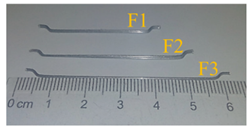Abstract
In recent years, the field of construction engineering has experienced a significant paradigm shift, embracing the integration of machine learning (ML) methodologies, with a particular emphasis on forecasting the characteristics of steel-fiber-reinforced concrete (SFRC). Despite the theoretical sophistication of existing models, persistent challenges remain—their opacity, lack of transparency, and real-world relevance for practitioners. To address this gap and advance our current understanding, this study employs the extra gradient (XG) boosting algorithm, crafting a comprehensive approach. Grounded in a meticulously curated database drawn from 43 seminal publications, encompassing 420 distinct records, this research focuses predominantly on three primary fiber types: crimped, hooked, and mil-cut. Complemented by hands-on experimentation involving 20 diverse SFRC mixtures, this empirical campaign is further illuminated through the strategic use of partial dependence plots (PDPs), revealing intricate relationships between input parameters and consequent compressive strength. A pivotal revelation of this research lies in the identification of optimal SFRC formulations, offering tangible insights for real-world applications. The developed ML model stands out not only for its sophistication but also its tangible accuracy, evidenced by exemplary performance against independent datasets, boasting a commendable mean target-prediction ratio of 99%. To bridge the theory–practice gap, we introduce a user-friendly digital interface, thoroughly designed to guide professionals in optimizing and accurately predicting the compressive strength of SFRC. This research thus contributes to the construction and civil engineering sectors by enhancing predictive capabilities and refining mix designs, fostering innovation, and addressing the evolving needs of the industry.
1. Introduction
Today, the world consumes 14 billion cubic meters of concrete annually, equating to approximately 4.4 tons per individual [1]. Despite its popularity, concrete has some inherent difficulties that limit its use under harsh weather conditions and in modern architectural designs. A major drawback of concrete is its relatively low tensile strength. Reinforced concrete (RC) structures are traditionally designed without considering this property, constituting approximately 6 to 12% of the normal concrete’s compressive strength (CS) [2,3,4]. Using discrete, randomly distributed, and discontinuous steel fibers in concrete reinforces the mix to mitigate problems [5,6,7]. This type of composite material is known as steel-fiber-reinforced concrete (SFRC). Consequently, RC members can be enhanced in crack resistance by using this easy-to-manufacture and highly effective technology [8].
Concrete stands out as the foremost building material employed extensively across the global construction industry, thanks to its unparalleled attributes of durability, strength, and sustainability [9,10,11]. In this framework, steel-fiber-reinforced concrete (SFRC), enhanced with short discrete fibers as mass reinforcement, emerges as an exceptionally effective cement-based composite capable of substantially alleviating the inherent brittleness found in plain concrete [12]. The incorporation of fibers into concrete represents a pivotal enhancement, notably augmenting its strength, toughness, crack resistance, and tension performance. This transformative impact arises from the adept intervention of randomly distributed fibers, skillfully restraining the unstable propagation of cracks, operating seamlessly at both the micro and macro levels [13]. Remarkably, SFRC exhibits a phenomenon known as strain-softening behavior, persisting even after the emergence of macro-cracks—a testament to the significant crack control offered by these fibers [14]. The introduction of steel-fiber reinforcement into concrete goes a step further, markedly elevating its ductility and toughness. The observed result can be chiefly ascribed to the incorporation of additional fracture mechanisms and the energy invested in overcoming the interlocking and adhesive forces existing between the fibers and the cementitious matrix [15]. To evaluate the improvement in ultimate properties, it is imperative to conduct mechanical tests, and the determination can only be ascertained upon the completion of the loading phase. Recent developments have underscored the utility of acoustic emission as a means to evaluate the performance of SFRC beams [16]. Furthermore, it is noteworthy that the formation of macro-cracks has the potential to induce the corrosion of steel reinforcement. Therefore, the reduction in crack width, achieved through the presence of fibers, assumes paramount importance in enhancing the durability of reinforced concrete (RC) structural elements [17]. Furthermore, compelling evidence suggests that the inclusion of steel fibers may reduce the need for conventional steel shear reinforcement. This conclusion is drawn from a comprehensive array of tests and analyses conducted by the authors and other esteemed researchers in the field [18,19,20].
SFRC was patented by Bernard in 1874 for strengthening concrete in tension, using steel splinters to achieve this purpose [21]. In the ensuing years, this exploration has led to many studies being conducted on its microstructure [22,23], flowability, and SFRC’s behavior under tension [24,25], durability [26,27,28], and strength under extreme and cyclic loadings [28,29,30]. In recent years, several new types of fibers have been proposed as reinforcements for SFRC, along with the use of magnetic fields to align the steel fibers during casting [30,31], and micro-scale numerical analyses have been published to illustrate the fundamental failure mechanism of SFRC under varying external loads [32,33]. According to these studies, SFRC has substantially different strength and elasticity properties than traditional concrete. For the post-cracking response, the SFRC is positively influenced by the high tensile resistance and elasticity that results in a crack-bridging mechanism. Hence, this composite material has excellent behavior under tension and shear loadings. A large extent of mechanical property variability is, however, a result of material heterogeneity. A steel-fiber reinforcement can prevent macrocrack propagation in concrete, but the resulting SFRC may be less flowable than its conventional equivalent. The quality reduction is likely caused by the interference between aggregates and fibers [33].
A significant consideration in civil engineering applications revolves around the urgent requirement for vigilance and the implementation of cutting-edge state-of-health identification techniques within current infrastructural frameworks [34]. An effective solution to this challenge involves continuous, real-time surveillance conducted in-situ to detect potential structural issues, including damage from cracking or yielding of steel reinforcements, and subsequently assess their severity levels [35]. The avant-garde technology of structural health monitoring (SHM), utilizing intelligent materials and systems, has become instrumental in assessing the internal state of reinforced concrete (RC) structures under both normal operational conditions and during critical loads. Notably, piezoelectric lead zirconate titanate (PZT) transducers have garnered widespread acclaim in electro-mechanical-admittance-based (EMA-based) health monitoring, primarily due to their favorable attributes [36,37]. Recent studies have showcased the successful deployment of the EMA technique, incorporating small-sized PZT transducers that are either surface-bonded or embedded, to identify damage in RC structural components [34,38]. Incorporating piezoelectric materials into SHM techniques presents a multitude of advantages, encompassing a high-frequency response, structural simplicity, cost-effectiveness, and the capability to generate an electrical signal through the application of mechanical force. However, certain limitations and uncertainties come to the forefront, particularly when applied to cracked, damaged, or non-homogeneous construction materials like RC. Identifying the severity and location of structural damages can prove challenging, as low-level damage occurring near the piezoelectric transducer’s placement can yield similar results to more extensive damage situated farther away [34].
A design-oriented formulation for the key mechanical properties of SFRC is necessary for the calculation of their key performance characteristics to facilitate their successful implementation in practical applications. However, the existing models tend to be either insufficiently accurate or lack physical relevance. In the literature, there have been several studies [39,40,41] proposing linear empirical formulas for predicting SFRC mechanical properties. There is a general consensus that fiber dosage and water-binder ratio play the greatest role in determining SFRC behavior. A composite material mixing theory indicates that SFRC properties strongly correlate with matrix and steel-fiber elastic properties. This theoretical background has been used as a foundation for the development of various empirical models [42]. In spite of the fact that some of the currently available empirical models are capable of accurately predicting the results of a small number of tests [7,43], the development and implementation of comprehensive and robust models are still in the early stages of development.
Machine learning (ML) and ML interpretability algorithms find extensive application in various aspects of structural engineering. These applications encompass a wide range of sectors within the realm of structural engineering, spanning structural analysis, design, monitoring structural health, detecting damage, evaluating fire resistance in structures, assessing the resistance of structural elements under various loads, and examining the mechanical properties as well as the mix design of concrete [44]. As an illustration of the capabilities of these techniques, Zheng et al. [45] successfully employed a YOLO-v5 model to detect surface cracks on wind turbines. Similarly, Cardellicchio et al. [46] leveraged ML to facilitate the recognition and interpretation of defects for the purpose of risk management in heritage bridge preservation.
The use of machine learning (ML) to model SFRC’s mechanical properties has become increasingly popular over the last few years. In this context, the back-propagation artificial neural network (ANN) approach has been utilized to calculate SFRC’s CS by Açikgenç et al. [43]. Their study used the aggregate size at maximum fiber dosage, length, and size, as well as fiber length and size, as input variables. In a similar manner, Awolusi et al. [47] used an ANN method to predict the flowability, CS, and splitting strength of SFRC. In addition, Karahan [48] used multiple nonlinear regression techniques in conjunction with ANN to predict the long-term strength of SFRC containing varying levels of fly ash. While these closed-source databases may be able to provide accurate estimates of SFRC mechanical properties, their limitations remain a concern. There have been criticisms of these models for their deficiencies, which include a lack of a physical mechanism illustration and a lack of an application tool. Recently, Pakzad et al. [7] have employed various data-driven machine-learning algorithms to predict the CS of SFRC. Sensitivity and parametric analyses were performed to demonstrate the capabilities of ML algorithms in their study.
In this study, we present solutions to the above-mentioned by focusing on the CS of SFRC-containing mono-fibrous (crimped, hooked, and mil-cut) systems. The research has been completed in several phases to achieve the goal. First, a comprehensive database of 420 records collected from 43 published studies was compiled and refined to establish a representative sample population. The second component of this research involves constructing and evaluating a numerical model that uses a state-of-the-art ML technique (XG Boost). A third aspect of the study involved narrowly focused experiments designed to verify the developed model using 30 SFRC mixes. Fourth, the model parameters were ranked according to their importance, and partial dependence plots were constructed to visualize their relationships. An intuitive graphical user interface was developed to enhance the model’s applicability.
ML has seen increased application in modeling SFRC properties. However, many current ML models for this purpose are “black boxes” that lack transparency and physical relevance, and also present implementation challenges. Moreover, globally, there is significant consumption of concrete, which, despite its popularity, has inherent limitations, including its relatively low tensile strength. The necessity to improve the transparency, relevance, and implement-ability of ML models for SFRC properties, combined with the global demand for more durable and versatile concrete solutions, drives this research. Existing models for predicting and optimizing SFRC properties using ML lack transparency, do not have a clear physical basis and are challenging to implement in practical scenarios. This study introduces an innovative approach that utilizes the extreme gradient (XG) boosting algorithm for predicting and optimizing the CS of SFRC. The approach is grounded in a comprehensive database, which is a compilation from 43 publications, and is validated through extensive experimental studies. The ML model developed in this research not only promises superior predictive capabilities against independent experimental data but also introduces a user-friendly interface, paving the way for more accessible and efficient predictions and optimizations in the realm of SFRC. This study represents a transformative effort within the construction industry landscape. Although ML techniques have gained prominence in predicting material properties, a significant challenge endures—the lack of transparency and practical relevance in existing models. To address this challenge and enhance real-world applicability, this research adopts a meticulous approach, leveraging the XG boosting algorithm. Furthermore, the investigation gains clarity through the application of partial dependence plots (PDPs), which reveal intricate connections between input parameters and the CS of SFRC. Of utmost importance, the current study uncovers optimal SFRC formulations, offering practical insights into the most effective combinations of fibers for real-world applications.
2. Methodological Approach
2.1. Background
The extreme gradient boosting (XG Boost) algorithm is a collective ML method that integrates a gradient boosting algorithm with decision trees to convert training data into a regression model suitable for classifying new data [49]. Due to Friedman et al.’s [50] introduction of the gradient boosting methodology, Chen et al. [51] developed an algorithm designed to enhance the performance of the gradient boosting methodology. In comparison to gradient boosting, the XG Boost algorithm can be distinguished from gradient boosting with several advantages, such as efficient tree partitioning, shorter nodes, randomization with Newton–Raphson boosting, and multi-objective optimization [52]. In recent years, it has become a very popular programming language because of its inclusion in Python and its use in several Kaggle [53] competitions. The model has demonstrated excellent predictive capabilities in identifying a person’s medical condition [54], forecasting the effects of the COVID-19 pandemic [55], and predicting a company’s probability of bankruptcy [56].
2.2. XG Boost Algorithm Development
In Figure 1, a conceptual diagram illustrates the steps involved in the preparation of an XG Boost algorithm, while the following equations provide a detailed formulation of the algorithm. It is noteworthy that Python (version 3.12.0) [57] was used for coding.
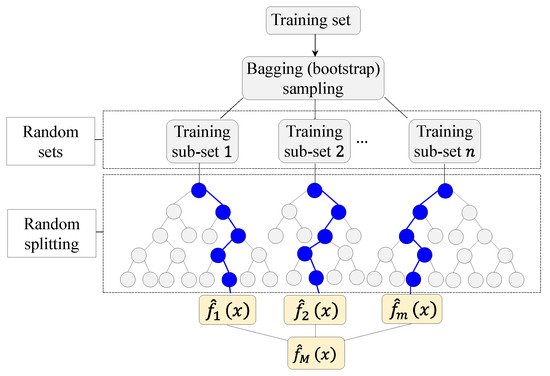
Figure 1.
XG Boost methodology.
In this study, the database of the SFRC involves variables with and the model’s output, , where M and N equal 420 and 12, respectively. Here, the first step involves the creation of a model’s output constant (initial) value [] using Equation (1). In the following step, the scores () and canvases () are evaluated by employing Equations (2) and (3), respectively. This step involves all nodes ( − ) having weak responses. As a result, the multi-objective condition [Equation (4)] can be solved using the training set , as a basis for fitting the base learner (tree). The model is then iteratively enhanced in accordance with Equation (5), following a process of optimization. The final results are then evaluated using Equation (6), following the calibration of the model. In Equations (1)–(6), is a loss function that behaves differently depending on differentiability, and is the learner’s rate of progress. It is important to note that, as part of the XG Boost single-tree analysis, is continually evaluated during the modeling process of each node to determine the node that will result in the highest gain over time. When features in are split into subsets, it is possible to create an additional regression tree. The accuracy of the model is calculated after adding up each predictor’s score to determine the total score for the model.
2.3. Indicators of Prediction Performance
As a means of testing the accuracy of the developed models with respect to the test observations of the characteristic CS of SFRC, four performance metrics (Equations (7)–(10)) were calculated in this study. In these formulas, , , and are the tested, calculated, and mean of tested CS of SFRC’s, respectively.
3. Data Collection, Characteristics, and Handling
3.1. Data Compilation
In this study, the primary focus was on the 28d CS of SFRC with three types of mono-fibrous systems (crimped, hooked, and mil-cut) as a response to the SFRC ingredients and their characteristics. In total, the unprocessed population of the study consists of 422 datasets collected from 43 independent reports that were published between the period of 1994–2021. The careful selection of these reports was guided by a comprehensive evaluation of accessibility, data richness, and alignment with research objectives in order to ensure the robustness and relevance of the datasets. As listed in Table 1 and Table 2, the variables in the study are coded according to the database’s inputs (X) and output (y). Moreover, Table 3 provides a summary of the collected datasets that were used in the study.

Table 1.
The coding system for the dummy variables.

Table 2.
The coding system for the non-dummy variables.

Table 3.
Summary of the collected CS database of SFRC.
The datasets for the current study were derived from the comprehensive database compiled by Wang et al. [8], which served as a basis for the present study. Their study focused on the mechanical characteristics of normal- and high-strength SFRC mixtures that only contained Portland cement (type I), natural aggregate, and a single type of steel fiber. A further aspect of ensuring the integrity of the compressive data has been achieved by considering the test specimen cylindrical with a diameter of 150 and a height of 300 mm. As a result, the conversion factors in Table 4 were applied to ensure consistency in the test results.

Table 4.
Data consistency conversion factors.
3.2. Data Wrangling and Statistical Analysis
3.2.1. Treatment of Outliers
Statistically significant outliers are data points that deviate from the norm, which indicates there could be an anomaly in the data [100]. It is common practice in regression analysis to deal with outliers as the first factor, which can significantly impact the outcome [101]. Several factors can contribute to detecting an outlier in a given data set; these include errors in measurement, mistakes made in capturing data, and signals detected in newly acquired data. In statistical models and analyses, outliers pose a challenge, particularly when the data involved in the analysis are excessive [102,103]. However, outliers present an exciting opportunity for exploring new possibilities. It is possible to identify outliers using various methods based on the type of data being analyzed and the type of outlier being sought. Furthermore, these methods can detect emerging phenomena or anomalous behavior. Some methods, such as Chauvenet’s criteria and Grubb’s test, are available for identifying outliers that use averages and standard deviations and assume a normal data distribution [53].
The variables included in the study were analyzed using descriptive statistics according to the method described in [104] to identify any outliers. Here, Grubb’s test was used during preprocessing to detect outliers, errors, and even distributions in the data by checking them for outliers, errors, and odd distributions. To achieve this objective, we employed the p-test for hypothesis testing, employing a significance level of 5%. The null hypothesis posits that all data values originate from the same normal population, while the alternative hypothesis contends that the largest or smallest data value is an outlier It is noteworthy that further critical analysis of the data is an essential measure for determining the weaknesses of the approach to enhance its effectiveness. This analysis has been carried out via bivariate boxplots, confirming the datasets’ regularity. An evaluation of the rationality of the datasets has been conducted using bivariate boxplots (Figure 2), which indicated the rationality of the datasets for further regression analysis. This figure provides an informative summary of the distribution characteristics (e.g., median, interquartile range, outlier, and skewness) of model variables, making them valuable tools for data exploration.
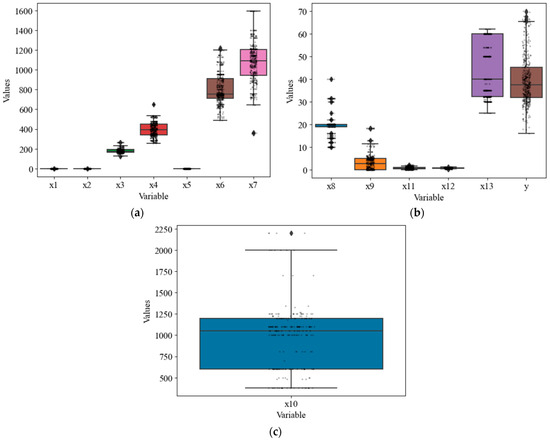
Figure 2.
Boxplots of the model variables: (a) X1–X7, (b) X8, X9, X11–X13, y, and (c) X10.
3.2.2. Data Descriptive Statistics and Visualization
After cleaning up the database, two outliers were removed ((i) MPa, and (ii) mm), thus leaving 420 observations available for developing the AI model. A summary of the statistical information obtained from the refined database after removing outliers is presented in Table 5, while Figure 3 displays their graphical visualization. The figure demonstrates that the distribution of the majority of these variables is well-suited for applications in machine learning.

Table 5.
Descriptive statistics of the processed datasets.
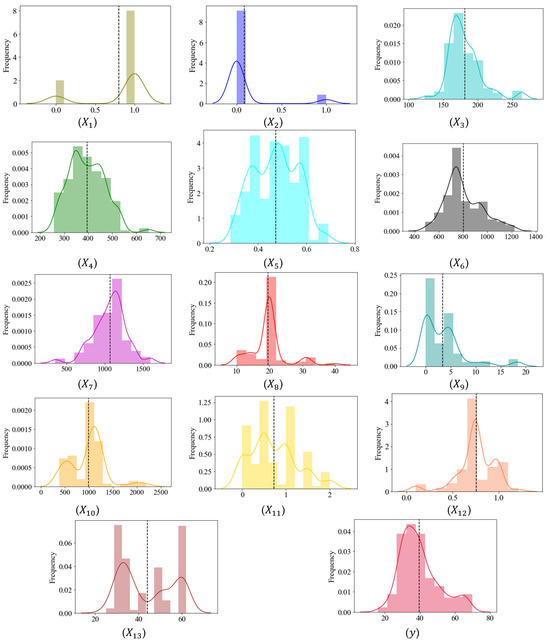
Figure 3.
A graphic depiction of the model’s variables.
4. Results and Discussion
4.1. Features and Label Relations
In the current study, a Pearson correlation constant ( Equation (11)) was calculated during data preprocessing to assess the linear correlation between the model variables. A constant with a value between −1 and 1 is always present in this equation [105]. In this equation, is the number of records, , ) is the number feature–label set having an average value of . In a linear relationship between two random variables, the constant represents the average degree of variability of the linear relationship. The resulting correlation constant coefficients for the features–label relations are presented in Figure 4. As shown in the figure, cement, HRWR contents, and fiber tensile strength (i.e., , , and ) had the largest positive impact on SFRC CS. The results obtained here are consistent with those of Ayan et al. [106]. The study demonstrated that the type and quantity of binder, along with the volume fraction of steel fiber, exerted the most pronounced influence on the compressive strength of SFRC. In contrast, increasing the proportions of water–binder ratio, water, and coarse aggregates (i.e., , , and ) would likely reduce CS. This finding can be explained by poor microstructural properties and packing densities resulting from increased water–binder ratio and coarse aggregate contents [107]. Furthermore, a comprehensive examination of the data depicted in Figure 4 explains that variables X6 (fine aggregate content) and X11 (diameter of fiber) will likely exert minimal influence on the CS of SFRC. Given their negligible impact, these specific variables have been thoughtfully excluded from subsequent analyses and modeling.
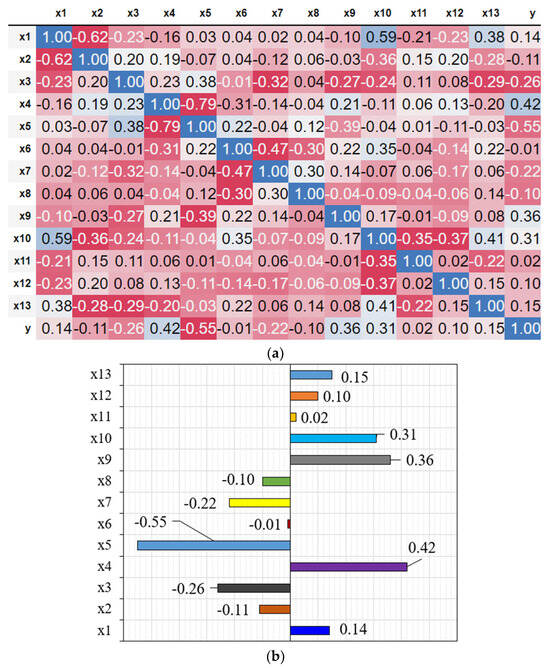
Figure 4.
(a) Pearson’s encoded matrix, and (b) linear correlations between features and label.
4.2. Development and Performance of the Initial Model
The default hyperparameters (Table 6) were used as a starting point for the development of the model (Model-0). It is worth noting that only the fine-tuned hyperparameters are included in this table. The prediction performance measures for this benchmark model are listed in Table 6. The initial model’s performance indicators for the test data were lower than those for the training data. Based on this finding, it appears that the initial model was prone to overfitting. Therefore, a multi-objective optimization process was used to fine-tune the default hyperparameters to maximize the model’s performance.

Table 6.
XG Boost hyperparameters for the initial and fine-tuned models.
4.3. Fine-Tuned Model
In the present study, the hyperparameters (Table 6) most affecting the model’s performance were optimized by trial and error to achieve the best accuracy. In the pursuit of refining the model’s default hyperparameters, we adopted a multi-objective optimization strategy that combines aspects of both random search and grid search. At each iteration of the approach, we methodically documented the model’s performance, facilitating the identification of an optimal configuration that effectively balances diverse performance objectives, encompassing the scores for both training and testing data. A favorable result was achieved using a multitarget optimization technique based on Pareto’s [108] frontier approach. Figure 5 depicts the results of this multi-objective optimization process. The optimized model exhibited adequate prediction performance with scores of 0.966 and 0.879 (Table 7) for training and testing data. As presented in Figure 6, the model-target results were close to the ±95% and ±85% accuracy ranges for both training and testing results, respectively. Additionally, the error of the predictions by the constructed model rarely exceeds ±30%. The model seems to be able to make accurate predictions for the database used during the modeling process. The next stage of the study involved a narrowly focused experimental campaign to verify the accuracy of the proposed ML model. The following section provides details of the experimental programs.
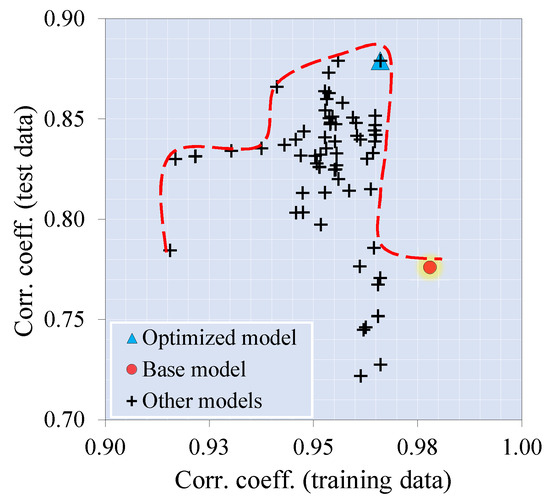
Figure 5.
Pareto frontier-based model’s multi-objective optimization.

Table 7.
Performance metrics of the initial and fine-tuned models.
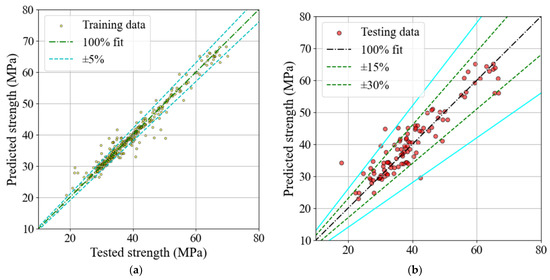
Figure 6.
Predicted vs. target results for the: (a) training and (b) testing data.
4.4. Experimental Verification
4.4.1. Materials
In this investigation, we utilized ordinary Portland cement (OPC) type I, in accordance with ASTM C 150 [109], to formulate the SF-HSC, procured from a local manufacturing facility. The estimated median particle size of this cement is 13 microns. A comprehensive analysis of the physicochemical attributes of the OPC employed is detailed in Table 8, while Figure 7 depicts the grain size distribution. Additionally, Figure 7 presents a scanning electron microscopy (SEM) image of the OPC, revealing distinctive features such as polyangular shapes, an asymmetrical distribution, and particle sizes ranging from 1 to 20 µm.

Table 8.
The physicochemical properties of the used OPC.
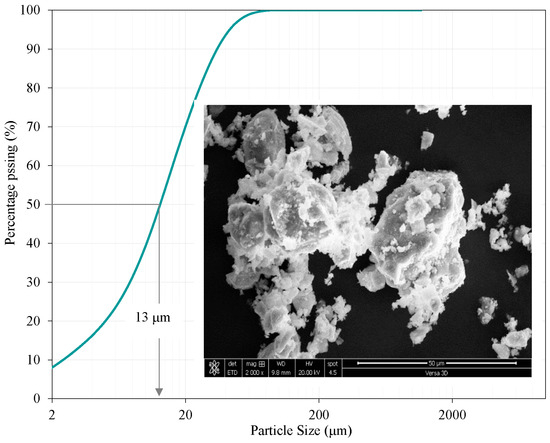
Figure 7.
SEM analysis and particle-size curves for the used OPC.
The targeted workability for the concrete blends was successfully attained through the utilization of a modified polycarboxylic ether polymer, recognized as a high-range water-reducing agent (HRWR) and commercially known as MasterGlenium 51. This HRWR comprises 36% dry powder and possesses a relative density of 1.1, as specified by the manufacturer. To determine the appropriate quantity of HRWR to incorporate into the concrete mix, we divided the dry extract (D.E.) by the weight of the cement. Optimizing this ratio has resulted in achieving the optimal workability for this specific mix.
Furthermore, all concrete blends were crafted with coarse aggregates (Ag) featuring a maximum aggregate size of 10 mm. The particle-size curves of the aggregates employed in this study are depicted in Figure 8.
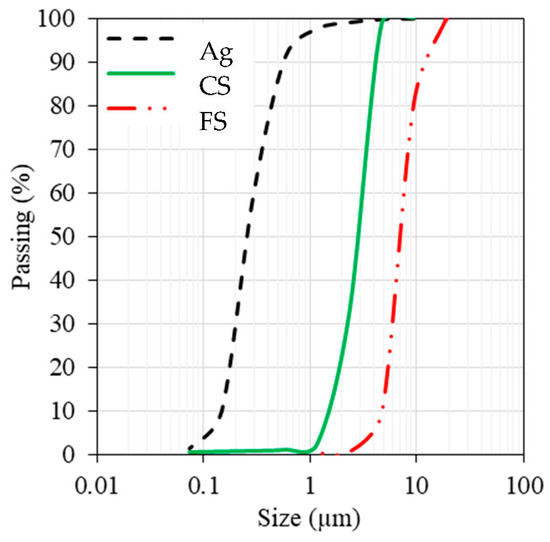
Figure 8.
Particle-size curves for various aggregates.
The production of SFRC involved the incorporation of three distinct hook-ended steel fibers, each varying in both length and diameter. The steel fibers utilized encompassed a range of dimensions. A comprehensive overview of the physicomechanical characteristics of the employed steel fibers is provided in Table 9.

Table 9.
Properties of the used steel fibers.
This investigation encompassed the formulation and assessment of 20 concrete blends, integrating three distinct water-cement ratios (0.25, 0.35, and 0.45), three varieties of fibers (as detailed in Table 9), and four levels of fiber dosage (0.0, 0.5, 1.0, and 1.5). The proportions of these mixes, along with the quantity of steel fibers incorporated in each, are outlined in Table 10. In this context, the labels U, H, and N signify concrete compositions featuring water–cement ratios of 0.25, 0.35, and 0.45, respectively. For instance, the designation “U-F1-0.5” indicates a mix prepared with a water–cement ratio of 0.25, utilizing steel fiber type “F1” at a dosage of 0.5 percent (volume). An important characteristic of the control blends is that the slump, serving as a measure of workability, was set at 100 ± 25 mm and assessed in accordance with ASTM C143 standards [110].

Table 10.
Test features and response.
4.4.2. Methods
Mixing, Casting, and Curing
Execution of this investigation involved blending various aggregates in a standard concrete mixer for several minutes, accompanied by the simultaneous introduction of absorption water. Subsequently, cement was dry-mixed for a brief duration. The high-range water-reducing (HRWR) agent was blended with water for two minutes, then re-mixed with the aggregates for three minutes, followed by an additional three minutes without mixing before the final two-minute blending phase. The resulting concrete mixture was poured into distinct molds, aligning with specimen size requirements, and the mixer was subsequently turned off. In the case of steel-fiber-reinforced concrete (SFRC) mixes, fibers were incorporated into the concrete mixture after a thorough initial mixing of five minutes to ensure optimal dispersion within the mixture.
Rigid plastic molds were utilized to cast a series of concrete cylinder specimens measuring 100 (dia.) × 200 (ht.) mm, assessing the compressive strength (CS) of the concrete. To maintain a conducive moisture environment, plastic sheets covered the specimens post-removal of excess material from the mold’s surface. Specimens were demolded after 24 h, and subjected to curing at 22 ± 2 °C with a relative humidity of 100%. The test specimens remained in this condition until the testing phase. Each type of test and mix underwent the casting of three specimens. For CS specimens, tests were conducted at both seven and 28 days. The study’s outcomes were then calculated, and average strength results for the three specimens were presented.
Method of Testing
Before subjecting the cylindrical specimens to the uniaxial compression test, a sulfur mortar coating is applied to ensure an even distribution of load across the top and bottom surfaces. This study assessed the compressive strengths (CSs) of cement-based materials at 7 and 28 days, adhering to ASTM C39 [111] specifications. Employing a ToniTech universal testing machine with a 3000 kN load capacity (depicted in Figure 9), the tests were conducted. The specimens were affixed with two linear variable displacement transducers (LVDTs) and a compressometer ring at a height of approximately 100 mm, corresponding to the center of the samples, to measure in-plane and transverse strains. Under displacement-controlled conditions, with a rate of 2.5 × 10−3 mm/s, the tests were executed. Each compressed test involved two or three duplicate samples, and the mean result was reported to ensure the reliability of the findings.
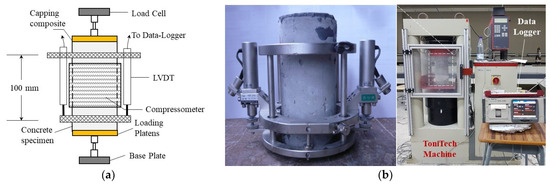
Figure 9.
The uniaxial compression test: (a) representatives chart and (b) testing system.
4.4.3. Test and Model Results
The observed and calculated CS of the studied SFRC mixes are listed in Table 10. The developed ML model yielded reasonable predictions. The mean and COV of the tested-to-predicted results were about 0.99 and 9%, respectively. A demonstration of this superior predictive capability is shown in Figure 10. In this figure, the predicted and tested data points show a low error rate of less than 10% in most cases.
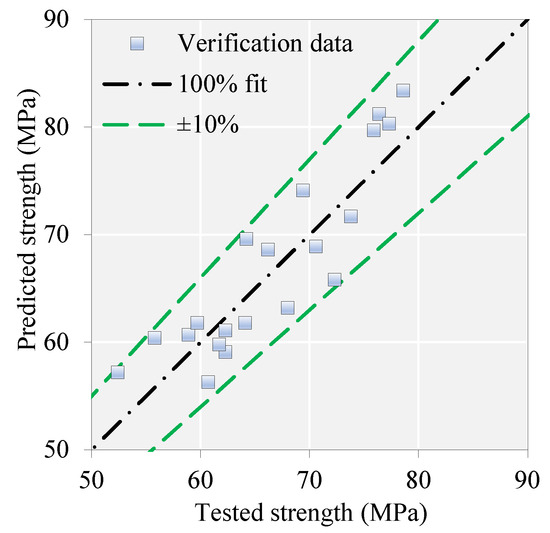
Figure 10.
Predicted vs. target results for experimental verification data.
5. Model Implementation
5.1. Feature Ranking
The analysis of influential variables in predicting the CS of SFRC plays a pivotal role in optimizing concrete mix designs for enhanced performance and durability. In this study, we employed two distinct approaches (Gini index [112] and Shapley additive explanations (SHAP)), to unveil the key factors that impact the CS of SFRC. These approaches provide valuable insights into the relative importance of different variables, shedding light on the interplay between various components within the concrete mixture. The practice of analyzing features based on Gini coefficients has proven to be more effective in detecting the significance of features with unique values [113]. The results of this analysis are shown in Figure 11.
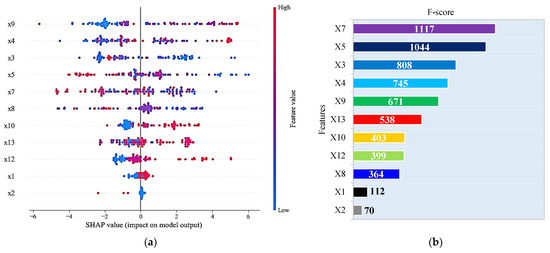
Figure 11.
Variable significance by: (a) SHAP value, and (b) Gini index methods.
The SHAP approach, a novel and robust tool for interpreting machine learning models, identified X9 (high-range water-reducer content), X4 (cement content), X5 (water–binder ratio), X7 (gravel content), and X8 as the most influential variables in predicting CS. The Gini index, another well-established technique for evaluating variable importance, identified a slightly different set of influential factors, namely X7, X5, X3, X4, X9, and X13. This divergence highlights the complementary nature of these two methods, as they provide unique perspectives on the significance of each variable. However, it is particularly noteworthy that both approaches unequivocally agree on four primary parameters significantly influencing the CS of SFRC: X9, X4, X5, and X7. Here, X9, representing the high-range water-reducer content, plays a crucial role in optimizing the workability and strength of the concrete mixture. Additionally, the cement content (X4) stands as a pivotal factor, as confirmed by Figure 11a, which visually depicts how higher cement content positively correlates with increased strength, while lower content results in reduced strength. The water–binder ratio (X5) and gravel content (X7) are also integral components, with their appropriate proportions contributing to the desired CS in SFRC.
It is noteworthy that the consistency in the rankings of other variables, such as coarse aggregate content (X6) and fiber type (X1 and X2), between the two methods, adds further credibility to our findings. These results not only underscore the robustness of our analysis but also provide valuable insights for optimizing SFRC mix designs. Importantly, these findings align with the results reported in Section 4.1 of this study, where the Pearson correlation analysis also highlighted the significance of X5, X4, and X9 in predicting the CS of SFRC. This collective evidence strengthens the confidence in the identified key parameters and their impact on the compressive strength of SFRC, offering a valuable foundation for future concrete mix design optimization efforts.
5.2. Partial Dependence Plots
This study conducted a partial dependence analysis for each independent variable employed in the ML model. Figure 9 shows the PDPs of the CS of SFRC in response to different predictors, except the dummy ones. The figure suggests the optimum water content () and HRWR () are in the range of 100–150 kg/m3 and more than 10–20 kg/m3 to maximize the CS, and strength notably decreases as the content increases. Further, the strength will likely increase as the cement content () increases. Additionally, the ideal content for coarse aggregate () content is perhaps 900–1100 kg/m3. Moreover, the results in the figure suggest that the best fibrous combination has a tensile strength () of about 1000 MPa, dosage () of around 1.0%, and length () of 40–50 mm. As expected, Figure 12 also illustrates that the CS decreases as the water–binder ratio () increases.
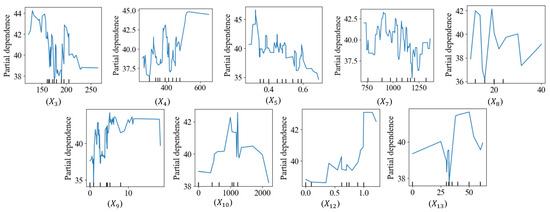
Figure 12.
Compressive strength of SFRC partial dependence plots.
5.3. Graphical User Interface Development
In this study, we provide an intuitive graphical user interface (GUI) for interacting with the developed XG Boost model. Python and Gradio [114] have been used to implement sliding control systems that allow input values to be limited to minimums and maximums (Table 5). Figure 13 shows three main components: input features with slider controls, output results, and SHAP-based explanations. The model produces the SFRC’s strength and the concrete class (“normal strength” if it has a strength lower than 60 MPa, otherwise “high-strength concrete”).

Figure 13.
A GUI for predicting the compressive strength of SFRC using the XG Boost model.
6. Conclusions, Implications, and Future Research
This study involved the compilation and refinement of an extensive database, comprising 420 entries sourced from 43 scholarly publications. We conducted experimental analyses on 20 different SFRC mixtures to assess the predictive accuracy of the constructed model. Furthermore, we employed PDPs to elucidate the relationships between the model’s input variables and its outcomes. The significance of these input variables within the model was also explored. To enhance the model’s usability, we developed a user-friendly graphical interface. It is worth noting that the research specifically focused on three distinct fiber types: crimped, hooked, and mil-cut. Therefore, the findings may not be directly applicable to SFRC with alternative fiber types or mixtures. Additionally, while the model consistently performed well with experimental data, its effectiveness may vary under different conditions or when using different raw materials. Regarding the research findings:
- The analysis, including Pearson correlations, Gini indices, and SHAP analyses, highlighted that the most significant factors influencing the CS of SFRC were the cement and HRWR contents, as well as the fiber tensile strength and water–binder ratio. Notably, increasing the proportion of water and coarse aggregates is likely to reduce the compressive strength of the concrete.
- We utilized the Pareto frontier multi-criterion method to develop an optimized version of the standard XG Boost model. Based on training and testing datasets, the optimized model demonstrated satisfactory predictive performance, achieving scores of 0.97 and 0.88, respectively.
- The developed ML model consistently exhibited superior predictive capability when tested against independent experimental data conducted by the authors, with average and COV values of the tested-predicted results at 0.99 and 6%, respectively.
- Through the application of PDPs, we determined that the optimal water and HRWR contents for achieving maximum CS are in the range of 100–150 kg/m3 and 10–20 kg/m3, respectively. Similarly, for coarse aggregates, ideal contents fall in the ranges of 900–1100 kg/m3. Additionally, the most effective fibrous combination exhibited a tensile strength of 1000 MPa, a diameter length of 40–50 mm, and a dosage of about 1.0%.
The adoption of ML techniques, particularly the XG boosting methodology, offers the construction and civil engineering sectors an enhanced predictive toolset for determining the CS of SFRC. This research not only elucidates optimal SFRC formulations, pinpointing effective fiber combinations but also facilitates the development of concrete with superior strength and durability. In future investigations, it would be valuable to compare the predictive competence of the current numerical model against existing empirical and analytical frameworks. Additionally, the inclusion of data on ultra-high-performance concrete could enhance the model’s universality. Addressing the size effect might benefit from the incorporation of a conversion factor as an input variable for various types of test samples, effectively contributing to handling this aspect of the study. While our present research offers a robust database, there is a compelling case for expanding this repository by incorporating newer studies and a wider array of SFRC mix variations, ensuring it remains at the forefront of technological progress. Despite the current study’s reliance on the XG boosting technique, exploring alternative ML schemes (e.g., neural networks or stacked ensemble algorithms) may reveal novel perspectives and enhance predictive accuracy. Beyond immediate CS predictions, there is a growing need to investigate the enduring resilience of SFRC in diverse scenarios. In an era emphasizing ecological responsibility, future research should critically assess the environmental implications of various SFRC formulations, including aspects such as lifecycle assessments, carbon emissions, and potential for recycling. Furthermore, forthcoming research endeavors could explore the impact of fiber orientation on the post-cracking behavior of SFRC under compressive loading.
Author Contributions
Conceptualization, Y.M.A. and M.I.K.; methodology, Y.M.A. and M.I.K.; software, Y.M.A.; validation, Y.M.A.; formal analysis, Y.M.A. and M.I.K.; resources, M.I.K.; writing—original draft, Y.M.A.; writing—review and editing, Y.M.A. and M.I.K.; supervision, M.I.K. All authors have read and agreed to the published version of the manuscript.
Funding
The authors extend their appreciation to Researcher Supporting Project number (RSPD2023R692), King Saud University, Riyadh, Kingdom of Saudi Arabia.
Institutional Review Board Statement
Not applicable.
Informed Consent Statement
Not applicable.
Data Availability Statement
Data are contained within the article.
Acknowledgments
The authors extend their appreciation to Researcher Supporting Project number (RSPD2023R692), King Saud University, Riyadh, Kingdom of Saudi Arabia.
Conflicts of Interest
The authors declare no conflict of interest.
References
- Bennett, B.; Visintin, P.; Xie, T. Global Warming Potential of Recycled Aggregate Concrete with Supplementary Cementitious Materials. J. Build. Eng. 2022, 52, 104394. [Google Scholar] [CrossRef]
- Sepulveda, B.D.G.; Visintin, P.; Oehlers, D.J. Fatigue Bond-Slip Properties of Steel Reinforcing Bars Embedded in UHPFRC: Extraction and Development of an Accumulated Damage Law. Case Stud. Constr. Mater. 2022, 17, e01370. [Google Scholar] [CrossRef]
- Abbas, Y.M.; Fares, G.; Iqbal Khan, M. Depth-Dependent Flexural Behavior of Plain and Bar-Reinforced Ultra-High-Performance Hybrid Fiber-Reinforced Concrete—Analytical, Numerical, and Uncertainty Modeling. Structures 2023, 52, 723–741. [Google Scholar] [CrossRef]
- Abellan-Garcia, J.; Fernández, J.; Khan, M.I.; Abbas, Y.M.; Carrillo, J. Uniaxial Tensile Ductility Behavior of Ultrahigh-Performance Concrete Based on the Mixture Design—Partial Dependence Approach. Cem. Concr. Compos. 2023, 140, 105060. [Google Scholar] [CrossRef]
- Abbas, Y.M.; Iqbal Khan, M. Fiber–Matrix Interactions in Fiber-Reinforced Concrete: A Review. Arab. J. Sci. Eng. 2016, 41, 1183–1198. [Google Scholar] [CrossRef]
- Qin, Y.; Su, J.; Cao, J.; Liu, R. Investigation of Orientation Coefficient on Meso-Damage Evolution of Steel Fiber-Reinforced Cement Composites. Eng. Fract. Mech. 2023, 284, 109210. [Google Scholar] [CrossRef]
- Pakzad, S.S.; Roshan, N.; Ghalehnovi, M. Comparison of Various Machine Learning Algorithms Used for Compressive Strength Prediction of Steel Fiber-Reinforced Concrete. Sci. Rep. 2023, 13, 3646. [Google Scholar] [CrossRef]
- Wang, Y.; Jin, H.; Demartino, C.; Chen, W.; Yu, Y. Mechanical Properties of SFRC: Database Construction and Model Prediction. Case Stud. Constr. Mater. 2022, 17, e01484. [Google Scholar] [CrossRef]
- Khan, M.I.; Abbas, Y.M. Intelligent Data-Driven Compressive Strength Prediction and Optimization of Reactive Powder Concrete Using Multiple Ensemble-Based Machine Learning Approach. Constr. Build. Mater. 2023, 404, 133148. [Google Scholar] [CrossRef]
- Abbas, Y.M.; Fares, G.; Khan, M.I. Impact of Hot Weather Conditions on the Performance of Supplementary Cementitious Materials Concrete. Sustainability 2023, 15, 8393. [Google Scholar] [CrossRef]
- Abbas, Y.M.; Hussain, L.A.; Khan, M.I. Constitutive Compressive Stress–Strain Behavior of Hybrid Steel-PVA High-Performance Fiber-Reinforced Concrete. J. Mater. Civ. Eng. 2022, 34, 04021401. [Google Scholar] [CrossRef]
- Guerini, V.; Conforti, A.; Plizzari, G.; Kawashima, S. Influence of Steel and Macro-Synthetic Fibers on Concrete Properties. Fibers 2018, 6, 47. [Google Scholar] [CrossRef]
- Ortiz Navas, F.; Navarro-Gregori, J.; Leiva Herdocia, G.; Serna, P.; Cuenca, E. An Experimental Study on the Shear Behaviour of Reinforced Concrete Beams with Macro-Synthetic Fibres. Constr. Build. Mater. 2018, 169, 888–899. [Google Scholar] [CrossRef]
- Bajpai, A.; Wetzel, B.; Klingler, A.; Friedrich, K. Mechanical Properties and Fracture Behavior of High-performance Epoxy Nanocomposites Modified with Block Polymer and Core–Shell Rubber Particles. J. Appl. Polym. Sci. 2020, 137. [Google Scholar] [CrossRef]
- Mujalli, M.A.; Dirar, S.; Mushtaha, E.; Hussien, A.; Maksoud, A. Evaluation of the Tensile Characteristics and Bond Behaviour of Steel Fibre-Reinforced Concrete: An Overview. Fibers 2022, 10, 104. [Google Scholar] [CrossRef]
- Mpalaskas, A.C.; Matikas, T.E.; Aggelis, D.G.; Alver, N. Acoustic Emission for Evaluating the Reinforcement Effectiveness in Steel Fiber Reinforced Concrete. Appl. Sci. 2021, 11, 3850. [Google Scholar] [CrossRef]
- Hollý, I.; Bilčík, J. Effect of Chloride-Induced Steel Corrosion on Working Life of Concrete Structures. Solid State Phenom. 2018, 272, 226–231. [Google Scholar] [CrossRef]
- Abbas, Y.M.; Tuken, A.; Siddiqui, N.A. Improving the Structural Behavior of Shear-Deficient RC Deep Beams Using Steel Fibers: Experimental, Numerical and Probabilistic Approach. J. Build. Eng. 2022, 46, 103711. [Google Scholar] [CrossRef]
- Cucchiara, C.; La Mendola, L.; Papia, M. Effectiveness of Stirrups and Steel Fibres as Shear Reinforcement. Cem. Concr. Compos. 2004, 26, 777–786. [Google Scholar] [CrossRef]
- Tarawneh, A.; Almasabha, G.; Alawadi, R.; Tarawneh, M. Innovative and Reliable Model for Shear Strength of Steel Fibers Reinforced Concrete Beams. Structures 2021, 32, 1015–1025. [Google Scholar] [CrossRef]
- Lantsoght, E.O.L. How Do Steel Fibers Improve the Shear Capacity of Reinforced Concrete Beams without Stirrups? Compos. B Eng. 2019, 175, 107079. [Google Scholar] [CrossRef]
- Wang, X.H.; Jacobsen, S.; He, J.Y.; Zhang, Z.L.; Lee, S.F.; Lein, H.L. Application of Nanoindentation Testing to Study of the Interfacial Transition Zone in Steel Fiber Reinforced Mortar. Cem. Concr. Res. 2009, 39, 701–715. [Google Scholar] [CrossRef]
- Lu, J.; Liu, J.; Fan, X.; Wan, X.; Gao, J.; Zhang, J.; Li, P. Study on the Mechanical Properties and Microstructure of Fiber-Reinforced Concrete Subjected to Sulfate Erosion. Arab. J. Sci. Eng. 2022, 47, 13639–13653. [Google Scholar] [CrossRef]
- Guojie, X.; Chuanlin, W.; Zhang, J.; Zeping, L.; Zhang, T.; Zhang, Y. Influence of Steel Fiber Shape on the Performance of High-Performance Concrete. Acta Mater. Compos. Sin. 2021, 38, 4313–4324. [Google Scholar]
- Wu, X.; Ding, F.; Xiang, P.; Wang, Y.; Yu, Z.; Liu, C. Multiaxial Damage Ratio Strength Criteria for Fiber-Reinforced Concrete. J. Eng. Mech. 2022, 148, 04022029. [Google Scholar] [CrossRef]
- Frazão, C.; Camões, A.; Barros, J.; Gonçalves, D. Durability of Steel Fiber Reinforced Self-Compacting Concrete. Constr. Build. Mater. 2015, 80, 155–166. [Google Scholar] [CrossRef]
- Liu, C.; Hunag, X.; Wu, Y.-Y.; Deng, X.; Zheng, Z.; Yang, B. Studies on Mechanical Properties and Durability of Steel Fiber Reinforced Concrete Incorporating Graphene Oxide. Cem. Concr. Compos. 2022, 130, 104508. [Google Scholar] [CrossRef]
- Parvez, A.; Foster, S.J. Fatigue of Steel-Fibre-Reinforced Concrete Prestressed Railway Sleepers. Eng. Struct. 2017, 141, 241–250. [Google Scholar] [CrossRef]
- Jin, L.; Zhang, R.; Dou, G.; Du, X. Fire Resistance of Steel Fiber Reinforced Concrete Beams after Low-Velocity Impact Loading. Fire Saf. J. 2018, 98, 24–37. [Google Scholar] [CrossRef]
- Liang, X.; Wu, C. Investigation on Thermal Conductivity of Steel Fiber Reinforced Concrete Using Mesoscale Modeling. Int. J. Thermophys. 2018, 39, 142. [Google Scholar] [CrossRef]
- Qing, L.; Zhang, H.; Niu, C.; Mu, R.; Li, M. Preparation and Fracture Behavior of Annularly Aligned Steel Fiber Reinforced Cementitious Composite: Experiment and Simulation. J. Build. Eng. 2023, 67, 106019. [Google Scholar] [CrossRef]
- Zhang, J.; Liu, X.; Wu, Z.; Yu, H.; Fang, Q. Fracture Properties of Steel Fiber Reinforced Concrete: Size Effect Study via Mesoscale Modelling Approach. Eng. Fract. Mech. 2022, 260, 108193. [Google Scholar] [CrossRef]
- Yu, Y.; Zhao, X.-Y.; Xu, J.-J.; Wang, S.-C.; Xie, T.-Y. Evaluation of Shear Capacity of Steel Fiber Reinforced Concrete Beams without Stirrups Using Artificial Intelligence Models. Materials 2022, 15, 2407. [Google Scholar] [CrossRef] [PubMed]
- Voutetaki, M.E.; Naoum, M.C.; Papadopoulos, N.A.; Chalioris, C.E. Cracking Diagnosis in Fiber-Reinforced Concrete with Synthetic Fibers Using Piezoelectric Transducers. Fibers 2022, 10, 5. [Google Scholar] [CrossRef]
- Mei, H.; Haider, M.; Joseph, R.; Migot, A.; Giurgiutiu, V. Recent Advances in Piezoelectric Wafer Active Sensors for Structural Health Monitoring Applications. Sensors 2019, 19, 383. [Google Scholar] [CrossRef] [PubMed]
- Talakokula, V.; Bhalla, S.; Gupta, A. Monitoring Early Hydration of Reinforced Concrete Structures Using Structural Parameters Identified by Piezo Sensors via Electromechanical Impedance Technique. Mech. Syst. Signal Process. 2018, 99, 129–141. [Google Scholar] [CrossRef]
- Huo, L.; Cheng, H.; Kong, Q.; Chen, X. Bond-Slip Monitoring of Concrete Structures Using Smart Sensors—A Review. Sensors 2019, 19, 1231. [Google Scholar] [CrossRef]
- Perera, R.; Torres, L.; Ruiz, A.; Barris, C.; Baena, M. An EMI-Based Clustering for Structural Health Monitoring of NSM FRP Strengthening Systems. Sensors 2019, 19, 3775. [Google Scholar] [CrossRef]
- Abbass, W.; Khan, M.I.; Mourad, S. Evaluation of Mechanical Properties of Steel Fiber Reinforced Concrete with Different Strengths of Concrete. Constr. Build. Mater. 2018, 168, 556–569. [Google Scholar] [CrossRef]
- Bai, M.; Niu, D.T.; Jiang, L.; Miao, Y. Research on Improving the Mechanical Properties and Microstructure of Concrete with Steel Fiber. Chin. Bull. Chin. Ceram. Soc. 2013, 32, 2084–2089. [Google Scholar]
- Chang, H.; Shen, P.; Gu, F. Analysis of the Influence Law of Steel Fiber on Concrete Thermal Conductivity and Pressure Strength. Concrete 2021, 4, 67–69. [Google Scholar]
- Wang, Y. Steel Fiber Reinforced Concrete Durability in the Atmospheric Environmental Based on Multi-Factor Effects. Ph.D. Thesis, Xi’an University of Architecture and Technology, Xi’an, China, 2011. [Google Scholar]
- Açikgenç, M.; Ulaş, M.; Alyamaç, K.E. Using an Artificial Neural Network to Predict Mix Compositions of Steel Fiber-Reinforced Concrete. Arab. J. Sci. Eng. 2015, 40, 407–419. [Google Scholar] [CrossRef]
- Thai, H.-T. Machine Learning for Structural Engineering: A State-of-the-Art Review. Structures 2022, 38, 448–491. [Google Scholar] [CrossRef]
- Zheng, Y.; Liu, Y.; Wei, T.; Jiang, D.; Wang, M. Wind Turbine Blades Surface Crack-Detection Algorithm Based on Improved YOLO-v5 Model. J. Electron. Imaging 2023, 32, 033012. [Google Scholar] [CrossRef]
- Cardellicchio, A.; Ruggieri, S.; Nettis, A.; Renò, V.; Uva, G. Physical Interpretation of Machine Learning-Based Recognition of Defects for the Risk Management of Existing Bridge Heritage. Eng. Fail. Anal. 2023, 149, 107237. [Google Scholar] [CrossRef]
- Awolusi, T.F.; Oke, O.L.; Akinkurolere, O.O.; Sojobi, A.O.; Aluko, O.G. Performance Comparison of Neural Network Training Algorithms in the Modeling Properties of Steel Fiber Reinforced Concrete. Heliyon 2019, 5, e01115. [Google Scholar] [CrossRef]
- Karahan, O.; Tanyildizi, H.; Atis, C.D. An Artificial Neural Network Approach for Prediction of Long-Term Strength Properties of Steel Fiber Reinforced Concrete Containing Fly Ash. J. Zhejiang Univ. Sci. A 2008, 9, 1514–1523. [Google Scholar] [CrossRef]
- Rathakrishnan, V.; Bt. Beddu, S.; Ahmed, A.N. Predicting Compressive Strength of High-Performance Concrete with High Volume Ground Granulated Blast-Furnace Slag Replacement Using Boosting Machine Learning Algorithms. Sci. Rep. 2022, 12, 9539. [Google Scholar] [CrossRef]
- Friedman, J.; Hastie, T.; Tibshirani, R. Additive Logistic Regression: A Statistical View of Boosting (With Discussion and a Rejoinder by the Authors). Ann. Stat. 2000, 28, 337–407. [Google Scholar] [CrossRef]
- Chen, T.; Guestrin, C. Xgboost: A Scalable Tree Boosting System. In Proceedings of the 22nd Acm Sigkdd International Conference on Knowledge Discovery and Data Mining, San Francisco, CA, USA, 13–17 August 2016; pp. 785–794. [Google Scholar]
- Wikipedia Contributors XGBoost. Available online: https://en.wikipedia.org/wiki/XGBoost (accessed on 29 August 2022).
- Wikiedia Contributors Outlier. Available online: https://en.wikipedia.org/wiki/Outlier (accessed on 20 October 2023).
- Kivrak, M.; Guldogan, E.; Colak, C. Prediction of Death Status on the Course of Treatment in SARS-CoV-2 Patients with Deep Learning and Machine Learning Methods. Comput. Methods Programs Biomed. 2021, 201, 105951. [Google Scholar] [CrossRef]
- Xu, H.; Wang, H.; Yuan, C.; Zhai, Q.; Tian, X.; Wu, L.; Mi, Y. Identifying Diseases That Cause Psychological Trauma and Social Avoidance by GCN-Xgboost. BMC Bioinform. 2020, 21, 504. [Google Scholar] [CrossRef] [PubMed]
- Carmona, P.; Dwekat, A.; Mardawi, Z. No More Black Boxes! Explaining the Predictions of a Machine Learning XGBoost Classifier Algorithm in Business Failure. Res. Int. Bus. Financ. 2022, 61, 101649. [Google Scholar] [CrossRef]
- Rossum, G.V.; Drake, J.F. Python Reference Manual; Centrum voor Wiskunde en Informatica: Amsterdam, The Netherlands, 1995. [Google Scholar]
- Yalcin, M. Optimization and Performance Based Design of Steel Fiber Reinforced Concretes; Istanbul Technical University: Istanbul, Turkey, 1994. [Google Scholar]
- Nili, M.; Afroughsabet, V. Combined Effect of Silica Fume and Steel Fibers on the Impact Resistance and Mechanical Properties of Concrete. Int. J. Impact Eng. 2010, 37, 879–886. [Google Scholar] [CrossRef]
- Nguyen-Minh, L.; Rovňák, M.; Tran-Quoc, T.; Nguyenkim, K. Punching Shear Resistance of Steel Fiber Reinforced Concrete Flat Slabs. Procedia Eng. 2011, 14, 1830–1837. [Google Scholar] [CrossRef]
- Ibrahim, I.S.; Che Bakar, M.B. Effects on Mechanical Properties of Industrialised Steel Fibres Addition to Normal Weight Concrete. Procedia Eng. 2011, 14, 2616–2626. [Google Scholar] [CrossRef]
- Eren, Ö.; Marar, K. Effects of Limestone Crusher Dust and Steel Fibers on Concrete. Constr. Build. Mater. 2009, 23, 981–988. [Google Scholar] [CrossRef]
- Şahin, Y.; Köksal, F. The Influences of Matrix and Steel Fibre Tensile Strengths on the Fracture Energy of High-Strength Concrete. Constr. Build. Mater. 2011, 25, 1801–1806. [Google Scholar] [CrossRef]
- Buratti, N.; Mazzotti, C.; Savoia, M. Post-Cracking Behaviour of Steel and Macro-Synthetic Fibre-Reinforced Concretes. Constr. Build. Mater. 2011, 25, 2713–2722. [Google Scholar] [CrossRef]
- Lau, A.; Anson, M. Effect of High Temperatures on High Performance Steel Fibre Reinforced Concrete. Cem. Concr. Res. 2006, 36, 1698–1707. [Google Scholar] [CrossRef]
- Shakya, K.; Watanabe, K.; Matsumoto, K.; Niwa, J. Application of Steel Fibers in Beam–Column Joints of Rigid-Framed Railway Bridges to Reduce Longitudinal and Shear Rebars. Constr. Build. Mater. 2012, 27, 482–489. [Google Scholar] [CrossRef]
- Soulioti, D.V.; Barkoula, N.M.; Paipetis, A.; Matikas, T.E. Effects of Fibre Geometry and Volume Fraction on the Flexural Behaviour of Steel-Fibre Reinforced Concrete. Strain 2011, 47, e535–e541. [Google Scholar] [CrossRef]
- Ünal, O.; Demir, F.; Uygunoğlu, T. Fuzzy Logic Approach to Predict Stress–Strain Curves of Steel Fiber-Reinforced Concretes in Compression. Build. Environ. 2007, 42, 3589–3595. [Google Scholar] [CrossRef]
- Carmona, S.; Aguado, A.; Molins, C. Characterization of the Properties of Steel Fiber Reinforced Concrete by Means of the Generalized Barcelona Test. Constr. Build. Mater. 2013, 48, 592–600. [Google Scholar] [CrossRef]
- Cantin, R.; Pigeon, M. Deicer Salt Scaling Resistance of Steel-Fiber-Reinforced Concrete. Cem. Concr. Res. 1996, 26, 1639–1648. [Google Scholar] [CrossRef]
- Pigeon, M.; Cantin, R. Flexural Properties of Steel Fiber-Reinforced Concretes at Low Temperatures. Cem. Concr. Compos. 1998, 20, 365–375. [Google Scholar] [CrossRef]
- Zhang, Z.C. Experimental Study on Constitutive Relation of Steel Fiber Reinforced Concrete under Uniaxial Compresion. Master’s Thesis, Zhengzhou University, Zhengzhou, China, 2017. [Google Scholar]
- Chen, J.Y. The Study of the Effect of Aggregate Size and the Steel Fiber’s Length on the Fracture Property of SFRC. Master’s Thesis, Zhengzhou University, Zhengzhou, China, 2016. [Google Scholar]
- Li, C.C. Study on Mechanical Properties and Relationship of Steel Fiber Reinforced Concrete Cubic and Cylindrical Specimen. Master’s Thesis, Zhengzhou University, Zhengzhou, China, 2016. [Google Scholar]
- Yue, J.; Xia, Y.; Fang, H. Experimental Study on Fracture Mechanism and Tension Damage Constitutive Relationship of Steel Fiber Reinforced Concrete. China Civ. Eng. J. 2021, 54, 93–106. [Google Scholar]
- Yang, Y. Effect of Fiber Dosage and Bond Length on Pullout Mechanical Property Study. Master’s Thesis, Guangzhou University, Guangzhou, China, 2015. [Google Scholar]
- Zhang, L.J. Mixture Design and Performance Calculation Method of Steel Fiber Recycled Concrete. Ph.D. Thesis, Zhengzhou University, Zhengzhou, China, 2016. [Google Scholar]
- Liao, L. Study on the Optimisation of Steel Fiber Reinforced Concrete; Taiyuan Technology University: Taiyuan, China, 2011. [Google Scholar]
- Fan, C.Y. Study on Mechanical Properties of Hybrid Steel Fiber Reinforced Concrete; Zhengzhou University: Zhengzhou, China, 2017. [Google Scholar]
- Yang, W.W. Experimental Study on Mechanical Properties and Durability of Fiber Reinforced Concrete; Shandong University: Jinan, China, 2012. [Google Scholar]
- Raja Rajeshwari, B.; Sivakumar, M.V.N. Influence of Coarse Aggregate Properties on Specific Fracture Energy of Steel Fiber Reinforced Self Compacting Concrete. Adv. Concr. Constr. 2020, 9, 173–181. [Google Scholar]
- Gao, C. Experimental Research on Mechanical Properties of Concrete and Reinfroced Oncrete after High Temperature; Yangzhou University: Yangzhou, China, 2013. [Google Scholar]
- Cheng, H.Q. Experimental Research on Adherence Property of Fresh Fiber Reinforced Concrete to Old Concrete. Ph.D. Thesis, Zhengzhou University, Zhengzhou, China, 2007. [Google Scholar]
- Liu, J. Study on the Relationship between Pressure and Tensile Properties of Steel Fiber Reinforced Recycled Concrete. Master’s Thesis, Zhengzhou University, Zhengzhou, China, 2016. [Google Scholar]
- Ma, Z.Y. An Experimental Study on the Properties of Steel Fiber Reinforced Concrete at Early Ages. Master’s Thesis, Beijing Technology University, Beijing, China, 2003. [Google Scholar]
- Li, Q.; Fang, Y.; Chen, Y.; Wu, Q.; Lin, G.; Pang, Z. Experimental Study on Mechanical Properties of Concrete with Adding Steel Fiber at Early Age. Concrete 2020, 6, 102–105. [Google Scholar]
- Zhu, T.Y. The Mechanical Properties of Steel Fiber-Reinforced Concrete at Low Fiber Content. Master’s Thesis, Zhengzhou University, Zhengzhou, China, 2011. [Google Scholar]
- Niu, L.L.; Zhang, S.P.; Wei, Y.X. Effect of Fiber Dosage on the Mechanical Property of SFRC. China Concr. Cem. Prod. 2019, 3. [Google Scholar]
- Peng, H.X. Experimental Research of Steel Fiber Reinforced Concrete on Speed-Repairing the Airport Pavement. Master’s Thesis, Beijing Technology University, Beijing, China, 2002. [Google Scholar]
- Gul, M.; Bashir, A.; Naqash, J.A. Study of Modulus of Elasticity of Steel Fiber Reinforced Concrete. Int. J. Eng. Adv. Technol. 2014, 3, 304–309. [Google Scholar]
- Minelli, F.; Conforti, A.; Cuenca, E.; Plizzari, G. Are Steel Fibres Able to Mitigate or Eliminate Size Effect in Shear? Mater. Struct. 2014, 47, 459–473. [Google Scholar] [CrossRef]
- Conforti, A.; Minelli, F.; Plizzari, G.A. Wide-Shallow Beams with and without Steel Fibres: A Peculiar Behaviour in Shear and Flexure. Compos. B Eng. 2013, 51, 282–290. [Google Scholar] [CrossRef]
- Cuenca, E. On Shear Behavior of Structural Elements Made of Steel Fiber Reinforced Concrete; Springer International Publishing: Cham, Switzerland, 2015; ISBN 978-3-319-13685-1. [Google Scholar]
- Characterization and Modelling of SFRC Elements; Universitat Politècnica de Catalunya: Barcelona, Spain, 2013.
- Facconi, L.; Minelli, F. Behavior of Lightly Reinforced Fiber Reinforced Concrete Panels under Pure Shear Loading. Eng. Struct. 2020, 202, 109879. [Google Scholar] [CrossRef]
- Conforti, A.; Zerbino, R.; Plizzari, G.A. Influence of Steel, Glass and Polymer Fibers on the Cracking Behavior of Reinforced Concrete Beams under Flexure. Struct. Concr. 2019, 20, 133–143. [Google Scholar] [CrossRef]
- Tiberti, G.; Minelli, F.; Plizzari, G. Cracking Behavior in Reinforced Concrete Members with Steel Fibers: A Comprehensive Experimental Study. Cem. Concr. Res. 2015, 68, 24–34. [Google Scholar] [CrossRef]
- Committee, A. 318 Building Code Requirements for Structural Concrete (ACI 318-19) and Commentary; American Concrete Institute: Farmington Hills, MI, USA, 2022. [Google Scholar]
- Wu, B.; Yu, Y.; Chen, Z.; Zhao, X. Shape Effect on Compressive Mechanical Properties of Compound Concrete Containing Demolished Concrete Lumps. Constr. Build. Mater. 2018, 187, 50–64. [Google Scholar] [CrossRef]
- Aggarwal, C.C. An Introduction to Outlier Analysis. In Outlier Analysis; Springer International Publishing: Cham, Switzerland, 2017; pp. 1–34. [Google Scholar]
- Atkinson, A.; Riani, M. Robust Diagnostic Regression Analysis; Springer: New York, NY, USA, 2000; ISBN 978-1-4612-7027-0. [Google Scholar]
- Pimentel, M.A.F.; Clifton, D.A.; Clifton, L.; Tarassenko, L. A Review of Novelty Detection. Signal Process. 2014, 99, 215–249. [Google Scholar] [CrossRef]
- Zimek, A.; Schubert, E.; Kriegel, H. A Survey on Unsupervised Outlier Detection in High-dimensional Numerical Data. Stat. Anal. Data Min. ASA Data Sci. J. 2012, 5, 363–387. [Google Scholar] [CrossRef]
- Khan, M.I.; Abbas, Y.M. Robust Extreme Gradient Boosting Regression Model for Compressive Strength Prediction of Blast Furnace Slag and Fly Ash Concrete. Mater. Today Commun. 2023, 35, 105793. [Google Scholar] [CrossRef]
- Wikipedia Contributors Pearson Correlation Coefficient. Available online: https://en.wikipedia.org/wiki/Pearson_correlation_coefficient (accessed on 20 October 2023).
- Ayan, E.; Saatçioğlu, Ö.; Turanli, L. Parameter Optimization on Compressive Strength of Steel Fiber Reinforced High Strength Concrete. Constr. Build. Mater. 2011, 25, 2837–2844. [Google Scholar] [CrossRef]
- Yu, J.; Zhang, B.; Chen, W.; He, J. Experimental and Multi-Scale Numerical Investigation of Ultra-High Performance Fiber Reinforced Concrete (UHPFRC) with Different Coarse Aggregate Content and Fiber Volume Fraction. Constr. Build. Mater. 2020, 260, 120444. [Google Scholar] [CrossRef]
- Pareto, V. Cours d’économie Politique; Librairie Droz: Geneva, Switzerland, 1964. [Google Scholar]
- ASTM C150/C150M-12; Standard Specification for Portland Cement. ASTM International: West Conshohocken, PA, USA, 2012; 9p.
- ASTM C143/C143M-12; Standard Test Method for Slump of Hydraulic-Cement Concrete. ASTM International: West Conshohocken, PA, USA, 2012; 4p.
- ASTM C39/C39M-14a; Standard Test Method for Compressive Strength of Cylindrical Concrete Specimens. ASTM International: West Conshohocken, PA, USA, 2014; 7p.
- Hastie, T.; Friedman, J.; Tibshirani, R. The Elements of Statistical Learning: Data Mining, Inference, and Prediction; Springer: New York, NY, USA, 2001; ISBN 978-1-4899-0519-2. [Google Scholar]
- Gong, J.; Chu, S.; Mehta, R.K.; McGaughey, A.J.H. XGBoost Model for Electrocaloric Temperature Change Prediction in Ceramics. NPJ Comput. Mater. 2022, 8, 140. [Google Scholar] [CrossRef]
- Abid, A.; Abdalla, A.; Abid, A.; Khan, D.; Alfozan, A.; Zou, J. Gradio: Hassle-Free Sharing and Testing of Ml Models in the Wild. arXiv 2019, arXiv:1906.02569. [Google Scholar]
Disclaimer/Publisher’s Note: The statements, opinions and data contained in all publications are solely those of the individual author(s) and contributor(s) and not of MDPI and/or the editor(s). MDPI and/or the editor(s) disclaim responsibility for any injury to people or property resulting from any ideas, methods, instructions or products referred to in the content. |
© 2023 by the authors. Licensee MDPI, Basel, Switzerland. This article is an open access article distributed under the terms and conditions of the Creative Commons Attribution (CC BY) license (https://creativecommons.org/licenses/by/4.0/).
